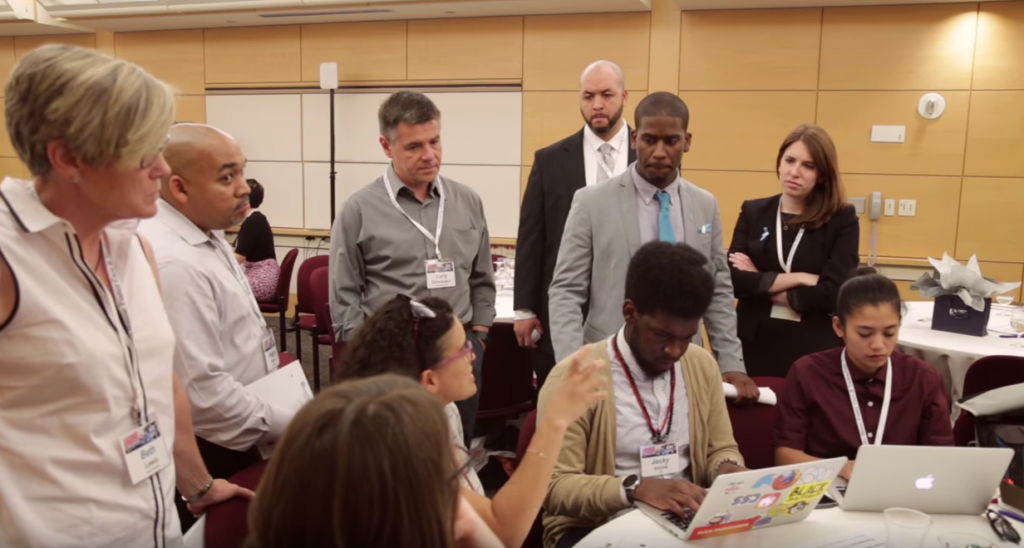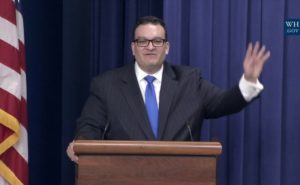The White House Hosts First-Ever Technology Hackathon to Improve Foster Care

*Photo credit: ChronicleOfSocialChange.org
Think about the impact technology has had on your life. Communication and daily activities have changed significantly as technology has progressed. While the world has become more digital, not enough technological solutions have reached the child welfare sector. In order to help foster the collaboration of child welfare agencies and technology companies, the White House, the U.S. Department of Health and Human Services, and Think of Us hosted the first ever Foster Care and Technology Hackathon on May 26-27 in Washington, D.C.

Commissioner Rafael Lopez of the Administration on Children, Youth and Families (ACYF) at the U.S. Department of Health and Human Services during day one of the event
Nonprofit organizations, child welfare leaders, philanthropists, engineers and leaders from the technology sector attended the two-day event to discuss ways to improve the foster care system through technology-focused solutions. The points of discussion included creating a framework to protect child welfare information, merging new technology into child welfare agencies, decreasing the rate of homelessness for youth aging out of foster care, and more.
As the first day of the event came to a close, several announcements were made about steps to increase the use of technology and improve outcomes for youth in the foster care system. For example, the U.S. Department of Education released a Foster Care Transition Toolkit with information to prepare young adults for the steps they must take to successfully transition to adulthood, specifically pursuing higher education, securing safe housing and joining the workforce. While this toolkit is primarily directed toward youth who are currently in foster care and young adults who have transitioned out of foster care, it provides great information and resources for supportive adults (guardians, relatives, social workers, teachers, etc.) who are making a positive difference in the lives of youth in foster care.
To read about more new policies, initiatives, and tools from the Technology Hackathon, read this press release from the White House: Fact Sheet: First Ever White House Foster Care and Technology Hackathon
KVC’s Telehealth Program for Children in Foster Care
KVC has been working to bring more technology solutions to not only its over 1,300 staff nationwide, but the children and families it serves. In 2014, the U.S. Department of Agriculture’s Rural Development Division awarded KVC a grant to launch its MyLink™ telehealth and distance learning program. MyLink is a robust, HIPAA-compliant video conferencing program that gives children in foster care and others served by the child welfare system increased access to therapeutic and crisis intervention services, and also delivers state-required training to foster parents in the home. In addition to therapy, crisis intervention and foster parent training, MyLink enables KVC to extend continuing education and required supervision for staff in rural, high-need areas. Pilot testing of the new technology has been completed and when fully implemented, MyLink will use iPads to transform the healthcare and support for children in more than 1,000 foster families in Kansas, Nebraska, Kentucky and West Virginia.
KVC’s Digital Case Planning Application
The talented technology team at KVC also recently created a new digitized application for case planning, enabling staff to make the best decisions with and for children and families. KVC’s Safe & Connected™ integrated child welfare practice model was developed by Sue Lohrbach, executive director of the KVC Institute for Health Systems Innovation, and is built on decades of experience in child welfare. The model emphasizes organizing information to promote critical thinking and collaboration with the family and other stakeholders. The fact that the model is now a web-based application allows social workers and other professionals to save time documenting and tracking, and instead invest their time and energy in the areas that require their gifts and insights: assessing, planning and implementing. This leads to improved outcomes for children and families.
A Specialized College for Youth in Foster Care
In addition to technological advances, KVC is leading a broadly-supported initiative to transform a closing naval base in West Virginia into a specialized career college for youth aging out of foster care. If the proposal comes to fruition, the ensuing Sugar Grove College could become a new national model for how to help a vulnerable population while creating jobs in the region, including an emphasis on employing military veterans. Learn more about the #NeverStopCaring campaign at www.kvc.org/sgc.
Read more about KVC’s leadership in technological innovation.
The White House Hackathon is a great first step toward exploring 21st century solutions for the child welfare sector. As more big ideas are shared and technological solutions are implemented, child welfare agencies will be able to draw from best practices in order to improve outcomes for youth in foster care.




